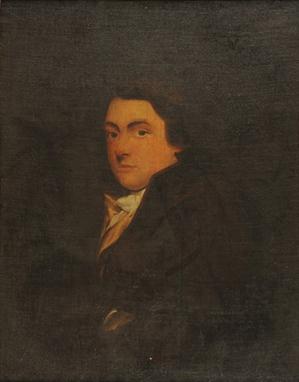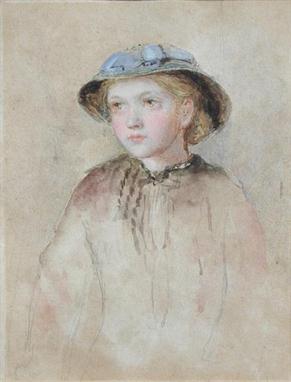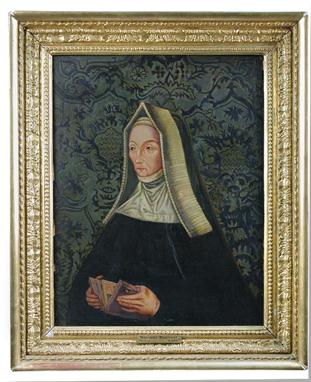283284 Preisdatenbank Los(e) gefunden, die Ihrer Suche entsprechen
283284 Lose gefunden, die zu Ihrer Suche passen. Abonnieren Sie die Preisdatenbank, um sofortigen Zugriff auf alle Dienstleistungen der Preisdatenbank zu haben.
Preisdatenbank abonnieren- Liste
- Galerie
-
283284 Los(e)/Seite
A STEVENSON (FL LATE 19TH CENTURY) PORTRAIT OF THE PRIZE DANDIE DINMONT TERRIER "CLEG" THE PROPERTY OF MR M H MILLS signed and with the artist`s printed label FROM A STEVENSON CANINE ARTIST Woodlands Place Market Place Nottingham on the reverse of the mount, ink and watercolour with bodycolour, oval, 12 x 15.5cm, unframed ++Laid onto the original card mount which is generally time stained and with cornice crease. Watercolour with minute spot of abrasion extreme lower centre, otherwise fine and unrestored
HUGH DOUGLAS HAMILTON (1736-1808) PORTRAIT OF ANNA TONELLI NÉE NISTRI bust length in a white turban and lace trimmed white dress, with inscription in a contemporary hand on the backboard Anna Tonelli ..... in London 1796, pastel, oval, 24 x 20.5cm The sitter, Anna Tonelli (Florence c1763-1846) was an accomplished portraitist in miniature and pastel. She came into contact with several English Grand Tourists in Italy in the 1780`s and there met Hamilton whose influence is apparent in her work. She was employed by Lord Clive and lived in London from 1794-97 before travelling with the Clive family to India in 1798. ++In fine condition in good quality later carved giltwood frame with sanded spandrels
SIR (JOHN) KYFFIN WILLIAMS, KBE, RA (1918-2006) PORTRAIT OF THE ARTIST pen, ink and wash, 17.5 x 13.5cm, unframed Provenance: as lot 716. ++Executed on a sheet of Cream Velvet notepaper and inscribed as an acceptance of an invitation, creased where folded and with other minor creases from having passed through the post and peripheral handling marks, but in good condition and amusing caricature
PAUL-PIERRE GOMEZ (19TH CENTURY) FAIR OF FACE signed, 44 x 37cm The French portrait painter Paul-Pierre Gomez was born at Bayonne and was a pupil of Albert Maignan. He was awarded an honourable mention in 1890 and at the Exposition Universelle, 1900 (Benezit). ++Two small old patched tears upper right and extreme lower left, in otherwise good original condition, not lined or otherwise restored, varnish reasonably clean, in good quality neo rococo giltwood and composition frame of the period
RICHARD HALL (1857-1942) PORTRAIT OF REAR ADMIRAL JAMES SACHEVERELL CONSTABLE SALMOND, RN (1882-1958) three quarter length in uniform on board ship, a telescope in his hands, signed, dated 1926 and inscribed Buenos Aires, 79 x 63.5cm Rear Admiral J S C Salmond entered the Royal Navy in January 1897 and rose to the rank of Captain in December 1920, becoming a Rear Admiral on his retirement in January 1933. He married on 18 November 1920 Miss Mary Anastasia Victoria Mostyn (1897-1946) ++In fine original condition, not lined, cleaned or restored, given to the late local private vendor by a descendent of the sitter. On the reverse of the stretcher the trade label of J J Patrickson 120 Fulham Road London
FOLLOWER OF MARY BEALE PORTRAIT OF A LADY bust length in blue gown, her dark hair curling over her right shoulder, in sculpted surround, 75 x 52cm, giltwood frame ++The support lined; cleaned and with localised restoration in ready to hang condition but not over varnished in old appropriate cushion moulded and carved frame with worn and chipped gilding
A VICTORIAN SANDSTONE SUNDIAL the 9 inch bronze horizontal dial indistinctly signed and with plain gnomon, on chamfered pillar with square capital, the sides with latin inscription and date 1838, on chamfered pillar with the raised initials EC/DT and stepped plinth, 106cm h The inscription reads: EDVARDVS T COKE DE BRIMINGTON ARMIG: ET DIANA NVPER TALBOT CROSBIE DE ARDFERT IN HIBERNIA CONIVX TEMPORIS NVNQVAM REDITVRI MEMORES ET FVTVRA SPERANTES. MONITOREM HVNC PONI CVRAVERVNT ANNO SALVTIS MDCCCXXXVIII. Erected at their home Brimington Hall (demolished 1931) the present sundial was commissioned by Colonel Edward Thomas Coke, DL, JP (1807-1888) of Brimington and Trusley, Derbyshire and Debdale Hall, Nottinghamshire. He married, in August 1835 Diana (d1895) daughter of the Rev. John Talbot-Crosbie of Ardfert Abbey, Co Kerry. They had three daughters. Colonel Coke was the son of D`Ewes Coke (d 1856) of Brookhill Hall, Pinxton, Nottinghamshire and Harriet Wright (d1815) of Mapperley Hall, Nottingham. A watercolour full-length portrait of Colonel Coke in uniform, when in Burma, painted jointly by himself and his wife, was sold from the Collection of Michael Appleby, Sotheby`s, 20 November 2000, lot 139. ++The bronze dial weathered and with green patina but probably original to the sone pillar, the capital with two large flat corner chips and minor edge knocks but in basically good original condition
WILLIAM BRIGHT MORRIS, ROI. (British, 1844-1896) Study of a young Spanish girl, full portrait sitting on the edge of a terracotta-tiled terrace, watercolour, initialled to lower left, 13.5 x 11.5cms, gilt frame moulded with oak leaves and acorns within an outer glazed ebonised frame, together with an art reference book Vassall-Adams Rory: The Victorian Watercolour
KUSTODIEV, BORIS (1878-1927) Portrait of Irina Kustodieva, signed, inscribed "Leysin" and dated 1911, further signed and inscribed in Cyrillic on the reverse. Tempera on cardboard, 107 by 81.5 cm. Provenance: Private collection, USA.Exhibited: World of Art Exhibition, St Petersburg, Moscow, Kiev, 1912, No. 135. Baltic Exhibition, Malmö, Sweden, 1914, No. 3126. The Russian Art Exhibition, Grand
MALIAVIN, PHILIPPE (1869-1940) Portrait of the Singer Nadezhda Plevitskaya, signed twice and dated 1924, further inscribed in Czech and with exhibition stamps on the reverse. Oil on canvas, 92 by 65 cm. Provenance: Acquired at the 1934 exhibition by Karl Veselik, Prague. The collection of Sona Cervená (B. 1925), a world renowned operatic mezzo-soprano, Czech Republic. Private collection, Europe.Authenticity of the work has been
ARKHIPOV, ABRAM (1862-1930) Female Portrait, signed. Oil on canvas, 118 by 71.5 cm. "Provenance: Acquired at MosKoopPromTorg in 1953, No. 11134 (label on the reverse). Private collection, Europe.Authenticity of the work has been confirmed by the experts O. Atroshchenko and V. Petrov.This impressive canv"
ROGINSKY, MIKHAIL (1931-2004) Self-portrait, signed, also signed, titled and inscribed in Cyrillic `Moscow` and dated 1974 on the reverse. Tempera on panel, 58 by 51 cm. Provenance: The Lili Brochetain collection, Paris. Literature: O. Medvedkina, The Brochetain Collection in Paris, from the series "Collecting as a Calling", Russkaya Mysl, January 1993, illustrated.
ZVEREV, ANATOLY (1931-1986) Portrait of Vladimir Nemukhin, signed and dated 1968. Pencil and watercolour on paper, 56.5 by 45 cm. Provenance: The A. Glezer collection. Acquired from the above.The Lili Brochetain collection, Paris.Literature: M. Fullenbaum, "Une collection revisitée: Brochetain", Univers Des Arts Magazine, p. 34, illustrated.
POGEDAIEFF, GEORGES (1894-1977) A Complete Set of Illustrations for Alexander Pushkin`s "The Queen of Spades", consisting of 16 finished illustrations, a portrait of Pushkin, a page with the artist`s coat of arms, 19 preparatory sketches and text, all finished illustrations signed, mostly with initials, the page with the coat of arms signed, inscribed with a dedication to the artist`s wife, inscribed "Paris" and dated "21/XI/46". Pencil, black crayon and charcoal on paper, each finished illustration measuring approximately 22 by 18 cm. The present volume of unpublished illustrations for Alexander Pushkin`s The Queen of Spades is a rare and particularly fine example of Georges Pogedaieff `s work as an illustrator. The drawings were completed in Paris in 1946, just a year af
Arnold Bronckhorst (Flemish, Active 1565-1583) Portrait of Oliver St John, 1st Baron St John of Bletso (1520-1582), wearing a Conical Hat and White Ruff, signed and dated "Arnold Bronkhorst fecit 1578" centre right, oil on panel. 47 x 39cm (18.33 x 15.21in). Provenance: By descent from the sitter in the St John family to The Lady Luke (the Hon. Laura St John), who married George Lawson Johnson, in 1902 1st Baron Luke (mother-in-law of the late owner). Exhibited: The Elizabethan Image, The Tate Gallery, London, 27.11.69 to 8.2.70, No.52. The Scottish National Portrait Gallery, Loan Exhibition for the Edinburgh Festival, 1975. Arnold Bronckhorst (Flemish 1565–1583) was a painter from the Netherlands who became Court Painter to James VI of Scotland. Arnold Bronckhorst came to London from the Netherlands, working at first with the English painter and miniaturist Nicholas Hilliard. Together they went to Scotland to procure gold for use in Hilliard`s miniatures. Although unsuccessful in obtaining warrants to export gold from Scotland, Bronckhorst was appointed on the recommendation of the Earl of Morton (circa 1525-1581) - Regent of Scotland from 1572-1578, during James VI`s minority - to paint portraits of the young King and his Court. In 1581 Bronckhorst was appointed Painter to the King, the first such appointment in Scotland, and given a yearly pension of £100. Bronckhorst later painted Morton, George Buchanan, the historian and poet, and the Earl of Arran. Royal letters, and account entries, from this time describe him as a "Flemyng". Bronckhorst returned to London in 1583 where he disappeared from public life, succeeded as Court Painter in Scotland by another Flemish artist, Adrian Vanson. Bronckhorst may have been the `Aart Van Bronkhurst` arrested at Dover in September 1585 as a follower of the French ambassador Michel de Castelnau. Only one signed and dated portrait by Bronckhorst survives; the present portrait of the English sitter Sir Oliver St John of Bletso. The barony of St John of Bletso, in the County of Bedford, created for Oliver St John in 1558 had a curious pre-history which linked its holder with some of the most powerful families in the kingdom. Oliver St John was a descendant of Sir John Oliver St John of Bletso (d. 1437), the husband of Margaret, great-great-granddaughter of Roger de Beauchamp (d. 1380), who was summoned to Parliament as Baron Beauchamp of Bletso from 1363 to 1379. Following the death of her first husband Margaret Beauchamp married John Beaufort, 1st Duke of Somerset. Her daughter by this marriage was Lady Margaret Beaufort, Countess of Richmond and Derby, who married Edmund Tudor, 1st Earl of Richmond, and became the mother of Henry VII of England. Oliver St John, 1st Baron St John of Bletsoe was therefore a kinsman of Lady Margaret Beaufort. He was born by 1522 and made his career in Parliament and in Bedford politics. He was returned to Parliament as one of the knights of Bedford in 1547, held a position in the household of Prince Edward, served as High Sheriff of Bedfordshire and Buckinghamshire in 1551, as a magistrate from 1554, and from 1560 to 1569 as Lord Lieutenant of Bedfordshire. He seems not to have returned to Parliament in 1552, devoting himself primarily to country affairs. In both national and Bedfordshire county affairs St John consistently demonstrated his allegiance to Queen Elizabeth from the outset. His reward was his elevation to the peerage in 1558 as Baron St John of Bletso, in the County of Bedford. His claims to a peerage were no doubt strengthened by the fact that he was regarded as heir of the line to the barony of Beauchamp of Bletso, though that title had been extinct since Roger de Beauchamp`s death in 1380. Little is known about Oliver St John`s later career, though he served at the trial of the Duke of Norfolk in 1571-2. By 1543, he had married Agnes Fisher, through whom he inherited considerable property in the Midlands. His second wife Elizabeth brought him further wealth, since two of her three previous husbands had provided generously for her. On his death in 1582, his successor was his son, John St John. The 2nd Baron St John was one of the peers who sat during the trial of Mary, Queen of Scots. He had no sons and was succeeded by his younger brother, Oliver St John, in 1596. In 1618, the barony passed to the latter`s son John, who was created 1st Earl of Bolingbroke in 1624. In the opinion of Sir Roy Strong in a letter to the late owner`s husband dated 1975 this portrait : " ... is unique for being the only fully signed work by this extremely obscure Elizabethan artist". We are grateful to Dr Joachim Whaley for his help with the catalogue entry
English School, Portrait of Margaret Beaufort, Countess of Richmond (1441-1509) oil on panel, 56 x 44cm (21.84 x 17.16in). Provenance: The Hon Hugh Lawson Johnson, Melchbourne Park, Bedfordshire, thence by descent. Margaret Beaufort was mother of Henry VII, the Founder of St John`s College and Christ`s College, Cambridge. She was born at Bletsoe Castle, Bedfordshire. Sir John St John was her half-brother. The original panel was, in 1904, in the possession of the 16th Baron St John at Melchbourne - copied from the original painting by Wilfred B Egan in December, 1904. Lady Margaret`s royal status was derived illegitimately from her paternal great grandfather, John of Gaunt, Duke of Lancaster – the fourth son of Edward III. Her father, John Beaufort, Duke of Somerset, was a disgraced military commander who died shortly before she was one year old. Subsequently, Lady Margaret was placed as a ward under the Marquess of Suffolk, who betrothed young Margaret to her son at the age of six. In 1453, the Lancastrian Henry VI dissolved the marriage and decided that she should instead marry Edmund Tudor, the son of Catherine of Valois, the Queen of Henry V, reinforcing the Lady`s royal status. Margaret Beaufort was the progenitor of the Tudor line. By the time Lady Margaret gave birth to Henry Tudor (at the age of 13) she was already a widow. After the murder of Henry VI in 1471 and the accession of the Yorkist Edward VI, she fled to France with her son, the next male in the Lancastrian family line. For further safety, Lady Margaret married Thomas, 2nd Baron Stanley, in 1472, a powerful figure and a Yorkist supporter at that time. Margaret accepted the Yorkist supremacy for the remainder of Edward`s reign, however after the accession of Richard III and the murder of the Princes in the Tower, she began to plot their overthrow and push for her son`s succession. Her involvement and the failure of the Duke of Buckingham`s rebellion in 1484 saw her estate handed over to the control of her husband, who also agreed to be her gaoler. Despite this, Lady Margaret continued to push for Richard`s overthrow and was instrumental in negotiating the marriage between her son and Elizabeth of York, an important match as it signified the union of the two houses of York and Lancaster, further increasing Henry`s claim to the throne. Lady Margaret`s role changed after Henry`s victory over Richard at the Battle of Bosworth Field in 1485. She began to sign her letters `Margaret R` and was granted large households in London and Northamptonshire, where she was effectively Henry`s Deputy in the East Midlands. She was also an established author and translator, publishing many religious tracts and patronising a number of centres of learning, such as St. John`s College, Cambridge. Sir John St John (1473-1512) was Chamberlain to Margaret, Countess of Richmond, and Executor of her Estate. Towards the end of her life, she became increasingly religious and devoted herself to a life of prayer. The present painting is a copy of the prototype in the National Portrait Gallery which dates from the 16th Century, and of which there are many copies and derivations
Burr walnut Trinity Lighthouse tea caddy, extensively inlaid with tea clippers, panels all surrounded with cross banding in various specimen woods. The interior similarly decorated with stained woods, the lids with bone handles. The interior of the lid fully lined with ormolu decoration and a central portrait. Artifacts made by British lighthouse keepers were marketed directly to the sailing captains and owners of the ships they aided. Fine inlaid woodwork is a tell-tale attribute of their learned craft, with parquetry and marquetry examples in existence. The Trinity House box, for letter writing, sewing and tea storage is very desired, as well as the uniquely stylised tables and ship models members of the service built.
English School (first quarter 19th century), Portrait of an officer in the Royal Staff Corps, shoulder length, 7.8cm x 5.7cm, oval, In a black papier mache rectangular frame. The Royal Staff Corps was a corps of the British Army which was founded circa 1800 and disbanded in circa 1837. It was generally responsible for short-term military engineering works, with the Royal Engineers and Corps of Royal Sappers and Miners remaining responsible for permanent works, but the boundaries between the functions of the corps were blurred. The Royal Staff Corps answered to the Quartermaster-General instead of to the Board of Ordnance. It also seems to have provided personnel for military police and orderly duties. On its disbandment most of its personnel transferred to the Royal Engineers and the Corps of Royal Sappers and Miners.
-
283284 Los(e)/Seite












































